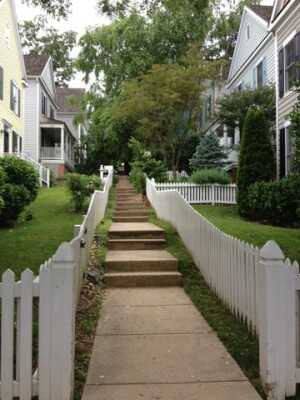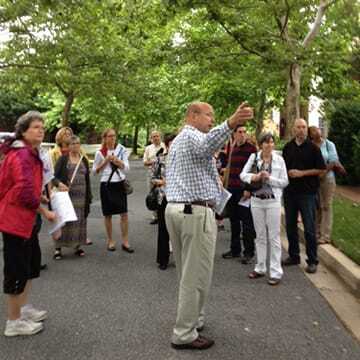It all started when developer Joe Alfandre, searching for a small-town alternative to the urban sprawl so dominant in the late 1980s, pioneered a concept that grew to become the Kentlands, an award-winning, 352-acre (142 ha), pedestrian-friendly neotraditional community in Gaithersburg, Maryland. Alfandre wanted to create a community similar to the one where he had grown up in Bethesda, Maryland, a place where neighbors knew each other, children could walk to school, and homeowners felt a sense of place. As owner of the Joseph Alfandre Company, he had purchased Kentlands Farm—complete with historic farm buildings in the rolling countryside of Montgomery County, Maryland—and enlisted Andrés Duany and Elizabeth Plater-Zyberk, architects, urban planners, and owners of Duany Plater-Zyberk & Company (DPZ), to make his revolutionary vision a reality.
After holding a charrette in an old barn on the property from June 1 through 8, 1988, where Alfandre, Duany, Plater-Zyberk, Gaithersburg mayor W. Edward Bohrer Jr., architects, urban planners, engineers, builders, an architecture professor from Harvard, and other professionals worked almost around the clock, the Kentlands Plan emerged. Among the many challenging ideas proposed for this suburban community were designs for mixed uses close to each other, live/work units, small lots (the smallest is 18 by 18 feet [5.5 by 5.5 m]), auxiliary apartment units, and narrow streets with on-street parking and alleys. But the team persisted, obtaining the requisite zoning permits, amendments, and whatever else was needed to make sure things complied with code.
Fast-forward 25 years to June 21, 2014, when residents of the Kentlands, architects, city planners, and others celebrated the silver anniversary of what originally seemed a radical development. The day began with a two-hour walking tour through the tree- and white-picket-fence-lined, mixed-use community, which includes single-family homes with front porches, cottages, townhouses, apartments, and live/work units built in proximity to each other and near the sidewalks with on-street parking to encourage neighbors to interact with each other. About 40 participants meandered along narrow streets, up winding alleys, along brick sidewalks, past pocket parks, and around manmade lakes, while professional architects and residents chimed in with anecdotes about the community, which received international coverage when it was conceived.
“Kentlands is dramatic testimony to the fact that design does affect behavior and can have a tremendous impact on our quality of life. Architects and planners have a powerful responsibility to shape our built environment for the benefit of future generations,” said Michael Watkins, founder and principal of Michael Watkins Architect, an architecture and town planning firm. He participated in the charrette, opened the DPZ D.C. office in the Kentlands in 1988 where he worked as town architect until 2007, and has lived and worked in the planned community for 25 years.
Louise Brodnitz, an architect and owner of Planning Places LLC, drove from Washington, D.C., to the Kentlands to take the walking tour, which Watkins led. “Kentlands is a delightful enclave. The movie It’s a Wonderful Life kept popping into my head, mostly because of the elusive quality of neighborliness that Kentlands vividly embodies,” she said. “Having never visited, I half expected it to be cloying or artificial, as critics of new urbanism sometimes claim. It was neither of those things, mostly because the randomness of nature always took priority; the existing landscape was honored.”
“Kentlands has matured far better than I might have thought. The ideas of locating the homes so close to the roads and allowing a significant portion of the parking to be on the street were both shocking concepts at the time. Many people said that this was not their version of suburban living. They wanted a bigger yard, not a porch, and an attached garage,” said Rose Krasnow, deputy director of Montgomery County’s planning department, who had visited the retail center to dine and go to the movies and had attended events at the Kentlands Mansion, built in 1852 and used as a cultural and civic center, over the years. But she had only driven past the residential portions. After taking the walking tour, she was “struck by wonderful streetscaping, the pedestrian connectivity, the design of the elementary school, and the detached accessory units that have been allowed in the Kentlands, despite the small lot size.”
Krasnow noted that some design features in the Kentlands would be difficult to approve today such as roads that were steeper than usual and intersections that did not line up in the traditional sense, because one road was offset. “Yet in terms of quality of life, all of these simply add to the ambience. The question is, are we designing intersections to move the maximum number of cars, or do we want to slow down traffic and make our neighborhoods safer for pedestrians? Kentlands is famous because it was one of the first neotraditional developments, and it started to change the way we think about what suburbia should look like.”
“It’s so wonderful to see communities caring about their places,” Plater-Zyberk, founding partner of DPZ, said after the walking tour. “I’m completely charmed by the frontyard gardens. There are some exquisitely planted gardens.”
After the tour, guests walked to have lunch in restaurants or at the farmers’ market in the town center, or their homes. A symposium held in the afternoon at the Montgomery County Public Safety Headquarters in Gaithersburg, which was attended by about 90 people, included passionate guest speakers sharing inspiring stories about the struggle it took to build the Kentlands and panel discussions about the community’s past, present, and future. One panel of young adults, who discussed their childhoods in the Kentlands, was among the highlights of the day.
Growing Up as a Kentlands Kid
Four 20-somethings discussed what it was like to grow up in the Kentlands where they could walk to school, explore woods and ponds, play on the “amazing” rope swing over the lake, and bike to the movie theater with friends. “I had a real childhood here,” said Nora Palka, a young actress who now lives in D.C.’s Bloomingdale neighborhood. “I could wander aimlessly in the neighborhood without shoes. I didn’t realize people had to be driven to their friends’ houses or that they had to drive to the grocery store,” said Emma Lister, a fourth-grade teacher who lives in D.C.’s Capitol Hill neighborhood. Jeremy Vest, a host at Largent’s Restaurant & Bar in the Kentlands, chimed in about how much fun Halloween is each year. “Swim team was a huge part of [my] growing up,” said Nick Hurson, a University of Colorado graduate who is living with his family and working as an intern in a land development office. He is still in touch with friends he made on the Kentlands’ swim team. “There’s sort of a social safety net—there were always three or four sets of parents you could reach out to. On the flip side, your parents would know if you did something wrong before you even got home. Sometimes the close-knit community was a little too close,” Hurson said.
Hurson’s father, Matt, shared what living in such a community means to him. He said Nick’s older brother, Edward, 26, is autistic. “He’s nonverbal, he can’t drive, but he walks to Starbucks on his own or with me.” And sometimes Edward walks around the neighborhood by himself. One evening, when he was taking a walk, the Hursons’ phone rang. A neighbor called and said, “Edward turned down a different street tonight, is that all right?” Sue Palka, a resident and meteorologist on Fox5, mentioned, “The neighborhood is self-selecting. You’re not going to want to live here if you’re not social.”
As noted, two of the four young adults who grew up in the Kentlands are now living in D.C. rather than in the Kentlands. Both say, however, that when the time comes for them to begin raising families, they would like to return to the Kentlands.
When families do move to the Kentlands, they often stay in the neighborhood. Melanie Alnwick, a reporter and news anchor for Fox5, is one example. When her family needed a bigger house, they moved from a 2,400-square-foot (223 sq m) cottage with two porches to a 3,000-square-foot (279 sq m) home with an open kitchen/great room. They moved a mere six doors away. “I miss my front porch, though; that was my favorite thing about the old house,” said Alnwick. The best part of her new house is the nearby alley. “Children from teens to toddlers are out there in the evenings, playing basketball, riding bikes, scooters, and skateboards, making chalk drawings, or creating their own versions of ‘kick the can’ or ‘ghost in the graveyard.’ The parents gather out there as well and socialize while we keep an eye on the children,” she said.
Alex Krieger, a principal at NBBJ, a global architecture and planning firm, who was invited to participate in the Kentlands charrette 25 years ago as a professor of architecture at the Harvard Graduate School of Design, says the experience was among the reasons he shifted his academic focus from strictly architecture to urban planning. He soon invited Plater-Zyberk and Duany to Harvard and edited the first book-length publication of their work, Towns + Town-Making Principles, published with the Harvard Graduate School of Design. Krieger later served as chairman of the Department of Urban Planning and Design from 1998 through 2004 and from 2006 through 2007. He has been a professor at the Harvard GSD since 1977.
When asked whether he was impressed after taking the walking tour and attending the Kentlands 25 Symposium, Krieger said, “Mostly yes—for what it is, it’s magnificent: a substantial improvement on the typical suburban environment. A lovely place to live and to grow up. If a major pull of the suburb was a belief that it was great for family nurturing, then Kentlands is a remarkable advance on that idea. But it remains demographically, economically, and socially somewhat homogeneous—great for raising a family, not so great for people in their 20s—and despite its impressive little ‘downtown’ main street, still more of a residential paradise than a bustling, diverse bit of urbanism.” Krieger added, “It’s a courageous, welcomed concept, beautifully executed, but it is not a universal solution.”
Kentlands: The Future
Even a quarter of a century after it was founded, the Kentlands is still influencing urban design. “I was in Denver recently, where the owners told developers they wanted the new development to look like Kentlands and all the developers came here,” said Stephen Wilcox, former executive vice president of the Joseph Alfandre Company, and the founder and president of Parkwood Homes, which has built more than 500 single-family homes, townhouses, and live/work units in communities in the D.C. and Denver metropolitan areas. “We host on average five groups a year, including one from Japan recently,” added Ailene Renzi, cochair of Celebrate Kentlands 25th.
Colin Greene, director of planning at HOK, a global design, architecture, engineering, and planning firm, and a longtime resident of the Kentlands, may have summed up the community best when he said, “The Kentlands is very human.”






